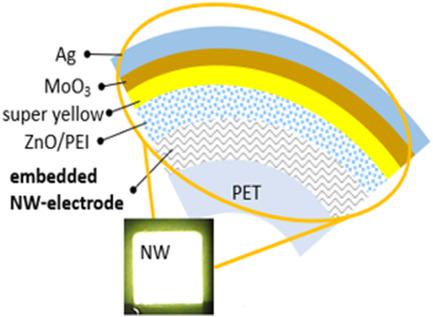当前位置:
X-MOL 学术
›
Phys. Status Solidi. Rapid Res. Lett.
›
论文详情
Our official English website, www.x-mol.net, welcomes your
feedback! (Note: you will need to create a separate account there.)
Implementation of Flexible Embedded Nanowire Electrodes in Organic Light‐Emitting Diodes
Physica Status Solidi-Rapid Research Letters ( IF 2.5 ) Pub Date : 2020-07-28 , DOI: 10.1002/pssr.202000305 Lukas Kinner 1, 2 , Felix Hermerschmidt 1 , Theodoros Dimopoulos 2 , Emil J. W. List-Kratochvil 1, 3
Physica Status Solidi-Rapid Research Letters ( IF 2.5 ) Pub Date : 2020-07-28 , DOI: 10.1002/pssr.202000305 Lukas Kinner 1, 2 , Felix Hermerschmidt 1 , Theodoros Dimopoulos 2 , Emil J. W. List-Kratochvil 1, 3
Affiliation

|
The implementation of silver nanowires (NWs) as flexible transparent electrodes (FTEs) in solution‐processed organic light‐emitting diodes (OLEDs) still faces two major challenges: the high roughness of NW films and heat sensitivity of the most commonly used transparent substrate poly(ethylene terephthalate) (PET). A solution‐based, roll‐to‐roll, and sheet‐to‐sheet scalable process to create indium tin oxide (ITO)‐free FTEs is reported. This FTE is realized by spraying NWs on PET, without the necessity of postdeposition heat treatment. To overcome the roughness limitation, NW films are reverse transfer embedded on another PET substrate. As a result, the FTE shows a low roughness, as well as high mechanical, thermal, organic‐solvent, and plasma stability. This developed FTE shows comparable transmittance with ITO but lower sheet resistance and higher mechanical stability. The FTE is implemented in a solution‐processed OLED with PDY‐132 (Super Yellow) as the emissive layer. In contrast to many other works in this field, a ZnO‐nanoparticle electron‐injection layer is used on the NWs instead of poly(3,4‐ethylenedioxythiophene) polystyrene sulfonate (PEDOT:PSS) or other organic hole injectors. The use of ZnO nanoparticles instead of organic layers yields many advantages in terms of process and device stability. The resulting devices show greater flexibility, conductivity, and luminance than PET/ITO reference devices, while having the same power efficacy.
中文翻译:

柔性嵌入式纳米线电极在有机发光二极管中的实现
在溶液处理的有机发光二极管(OLED)中将银纳米线(NW)用作柔性透明电极(FTE)仍然面临两个主要挑战:NW膜的高粗糙度和最常用的透明基板poly的热敏性(对苯二甲酸乙二酯)(PET)。据报道,基于解决方案的,卷对卷和片对片可扩展过程可创建不含铟锡氧化物(ITO)的FTE。该FTE是通过在PET上喷涂NW来实现的,无需进行沉积后热处理。为了克服粗糙度限制,将NW膜反向转移嵌入另一PET基板上。结果,FTE的粗糙度低,并且机械,热,有机溶剂和等离子体的稳定性也很高。这种开发的FTE显示出与ITO相当的透射率,但更低的薄层电阻和更高的机械稳定性。FTE在以PDY-132(超级黄)作为发射层的溶液处理OLED中实现。与该领域的许多其他工作相比,在NW上使用了ZnO纳米粒子电子注入层,而不是聚(3,4-乙烯二氧噻吩)聚苯乙烯磺酸盐(PEDOT:PSS)或其他有机空穴注入剂。ZnO纳米颗粒代替有机层的使用在工艺和器件稳定性方面产生了许多优势。与具有相同功效的PET / ITO参考器件相比,所得器件显示出更大的柔韧性,导电性和亮度。与该领域的许多其他工作相比,在NW上使用了ZnO纳米粒子电子注入层,而不是聚(3,4-乙烯二氧噻吩)聚苯乙烯磺酸盐(PEDOT:PSS)或其他有机空穴注入剂。ZnO纳米颗粒代替有机层的使用在工艺和器件稳定性方面产生了许多优势。与具有相同功效的PET / ITO参考器件相比,所得器件显示出更大的柔韧性,导电性和亮度。与该领域的许多其他工作相比,在NW上使用了ZnO纳米粒子电子注入层,而不是聚(3,4-乙烯二氧噻吩)聚苯乙烯磺酸盐(PEDOT:PSS)或其他有机空穴注入剂。ZnO纳米颗粒代替有机层的使用在工艺和器件稳定性方面产生了许多优势。与具有相同功效的PET / ITO参考器件相比,所得器件显示出更大的柔韧性,导电性和亮度。
更新日期:2020-07-28
中文翻译:

柔性嵌入式纳米线电极在有机发光二极管中的实现
在溶液处理的有机发光二极管(OLED)中将银纳米线(NW)用作柔性透明电极(FTE)仍然面临两个主要挑战:NW膜的高粗糙度和最常用的透明基板poly的热敏性(对苯二甲酸乙二酯)(PET)。据报道,基于解决方案的,卷对卷和片对片可扩展过程可创建不含铟锡氧化物(ITO)的FTE。该FTE是通过在PET上喷涂NW来实现的,无需进行沉积后热处理。为了克服粗糙度限制,将NW膜反向转移嵌入另一PET基板上。结果,FTE的粗糙度低,并且机械,热,有机溶剂和等离子体的稳定性也很高。这种开发的FTE显示出与ITO相当的透射率,但更低的薄层电阻和更高的机械稳定性。FTE在以PDY-132(超级黄)作为发射层的溶液处理OLED中实现。与该领域的许多其他工作相比,在NW上使用了ZnO纳米粒子电子注入层,而不是聚(3,4-乙烯二氧噻吩)聚苯乙烯磺酸盐(PEDOT:PSS)或其他有机空穴注入剂。ZnO纳米颗粒代替有机层的使用在工艺和器件稳定性方面产生了许多优势。与具有相同功效的PET / ITO参考器件相比,所得器件显示出更大的柔韧性,导电性和亮度。与该领域的许多其他工作相比,在NW上使用了ZnO纳米粒子电子注入层,而不是聚(3,4-乙烯二氧噻吩)聚苯乙烯磺酸盐(PEDOT:PSS)或其他有机空穴注入剂。ZnO纳米颗粒代替有机层的使用在工艺和器件稳定性方面产生了许多优势。与具有相同功效的PET / ITO参考器件相比,所得器件显示出更大的柔韧性,导电性和亮度。与该领域的许多其他工作相比,在NW上使用了ZnO纳米粒子电子注入层,而不是聚(3,4-乙烯二氧噻吩)聚苯乙烯磺酸盐(PEDOT:PSS)或其他有机空穴注入剂。ZnO纳米颗粒代替有机层的使用在工艺和器件稳定性方面产生了许多优势。与具有相同功效的PET / ITO参考器件相比,所得器件显示出更大的柔韧性,导电性和亮度。











































 京公网安备 11010802027423号
京公网安备 11010802027423号